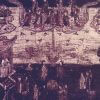The name Kudrun, and hence the title of a German epic, is rendered as “Gudrun” in most older English translations. But today the form “Kudrun” is preferred because Gudrun is also the name of an unrelated character in Norse mythology. Gudrun is a major figure in early Germanic literature that is centred on the hero Sigurd, son of Sigmund. She appears as Kriemhild in the Nibelungenlied and as Gutrune in Wagner’s Der Ring des Nibelungen.
Das Gudrunlied
Kudrun or “Das Gudrunlied” (The Gudrun-song), written probably in the early years of the 13th century, not long after the Nibelungenlied. It is preserved in a single manuscript, which was prepared at the command of Maximilian I, and was discovered as late as 1820 in the Ambras Castle in Tirol. The author was an unnamed Austrian poet, but the story itself belongs to the cycle of sagas, which originated on the shores of the North Sea’s Low lands.
Some have viewed Kudrun as not unworthy to stand beside the greater Nibelungenlied, and it has aptly been compared with it as the Odyssey to the Iliad. Like the Odyssey, Kudrun is an epic of the sea, a story of adventure; it does not turn solely round the conflict of human passions; nor is it built up around one all-absorbing, all-dominating idea as the Nibelungenlied is. Scenery and incident are more varied, and the poet has an opportunity for a more lyric interpretation of motive and character.

But what makes Kudrun significant is that women are portrayed in dominant roles. Not only are they the prizes that motivate the action of male warriors, as would be expected in chivalric romance, but in the case of Kudrun herself as well as her mother Hilde, they direct important episodes and determine the final outcome. The epic tells essentially three stories: the adventures of King Hagen, King Hetel’s winning of Hilde, and the trials and triumphs of Princess Kudrun, the latter taking up three-quarters of the work.
Norse mythology and Gudrun
In Norse mythology, Gudrun (Guðrún Gjúkadóttir) is the sister of king Gunnar. She falls in love with Sigurd, who does not care for her, as he is in love with the valkyrie Brynhild, to whom he once gave the ring of Andvaranaut. Gudrun’s brother Gunnar also wished to marry Brynhild, but this was impossible as she had sworn to marry only the man who could defeat her in a fair fight, whom she knew to be Sigurd.

Gudrun’s scheming mother, Grimhild, called Ute in the Nibelungenlied, mixes a potion to make Sigurd forget his love for Brynhild. Later, when Brynhild learns that she has been tricked into marrying the inferior Gunnar, she exacts vengeance by telling Gunnar that Sigurd had taken liberties with her, so Gunnar has Sigurd killed.
Gudrun is so overcome with grief at the death of the one she loves that she cannot weep. The royal court fears for her life, and when finally her sister shows Sigurd’s corpse to Gudrun, tears flow at last.
Gudrun laments her lost husband and predicts the death of his killer, her own brother Gunnar.
King Atli
Gudrun later marries king Atli (loosely based on Attila the Hun). In the northern version, Atli is responsible for the death of her whole family, who bear the name Völsung/Niebelungen after the Nibelung gold treasure.
The queen takes revenge for her murdered family by killing her two sons. She served Erp and Eitil to their father Atli at a feast. Then, when Atli is solidly drunk, she breaks the news to him:
Thou giver of swords, / of thy sons the hearts
All heavy with blood / in honey thou hast eaten;
Thou shalt stomach, thou hero, / the flesh of the slain,
To eat at thy feast, / and to send to thy followers.
Thou shalt never call / to thy knees again
Erp or Eitil, / when merry with ale;
Thou shalt never see / in their seats again
The sharers of gold / their lances shaping,
Gudrun sets fire to Atli’s hall, killing him along with all of his men. She tries to drown herself by jumping into the sea with an armful of stones. The waves find her revenge fitting, however, and instead of drowning her, they carry her to Sweden …
– more to come –




